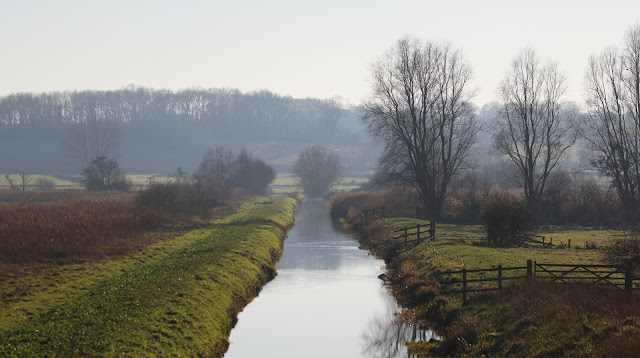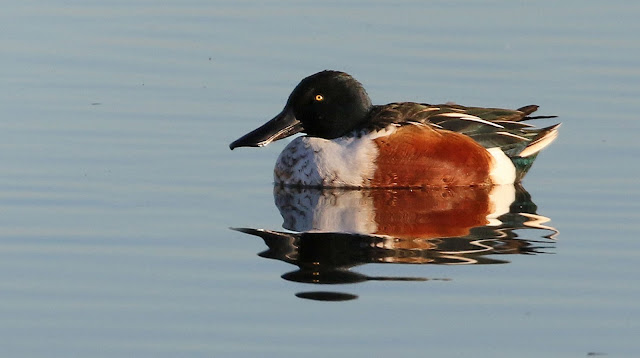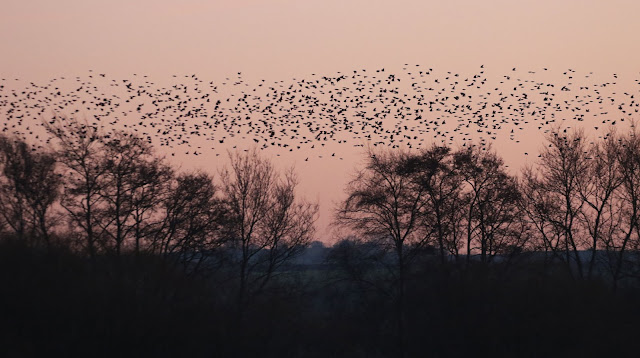Before the pandemic stopped us all from travelling, we had discovered a lovely pub, restaurant, hotel in the village of Litton in Somerset. In 2019 and 2020 we stayed there just after New Year, the trip in 2021 cancelled of course. But with no restrictions this year we were able to fulfill the reservation and so with a day off on the Friday we set off in frosty and misty conditions. We spent the morning in Bath, but in the early afternoon visited the RSPB reserve, Ham Wall in the Avalon Marshes area of the Somerset Levels.
It was a glorious afternoon with clear blue skies very little wind and that lovely golden winter light. The car park wasn't too busy on arrival, chances are that would change later. As I stood reviewing the latest sightings board a group of Long-tailed Tits performed their acrobatics in the nearby tree.
6,000 years ago most of what is now Somerset’s Levels and
Moors was open water and reed-bed, covering what had once been a shallow sea.
Over time the reed-bed was replaced by wet woodland and then by a raised bog.
This formed layers of peat. Step forward to the late 20th century; the demand
for horticultural peat was high and the Peat Industry expanded
rapidly, huge quantities of peat were removed, leaving behind a scarred
landscape.
We left the car park and visitor centre and made our way to the main path. The path crosses a canal, with lovely views away to the south.
The Glastonbury Canal, which runs through the reserve,
was opened in 1833. It was made obsolete from 1854 by the Somerset Central
Railway line that once ran next to it on its way from Glastonbury to Highbridge.
The railway line closed in 1966. The railway and the canal both carried
peat and people.
Ham Wall the reserve was born in the mid 1990s when the land was passed
to the RSPB. The objective was to re-create vital reedbeds and help the
struggling bittern population in the UK. The land was sculpted by machines,
RSPB volunteers and staff grew reed from seed. Then came the hardest part,
planting thousands of young reeds by hand.
The reserve name derives from the Ham Wall rhyne which flows
through the site. "Rhyne" is a local name for drainage channels
between plots of land, pronounced reens in the east and rhine in
the west of the Levels area. "Ham" is an old term for pasture or meadow,
and the Ham Wall may have been a bank to hold water on the flooded fields.
As we walked into the reserve going west to east the one dominant feature of the view in front of us was that of Glastonbury Tor. The hill rises 158m above the surrounding flat land and
rewards those on the top with a fine 360-degree view.
Despite the bright sunshine the moon was clearly visible, both in the sky and reflecting in the still water of the canal.
Stopping at the first viewing platform a Great Egret was sitting close to the reeds and open water.
The white plumage contrasting with the golden brown of the surrounding reeds.
Once again Shoveler were the dominant duck, groups dotted all over the open water and up against the reeds. Wigeon though could be heard, their whistles carrying far in the air.
The view from the said, Viewing Platform #1.
We continued along the main path, but when it became clear that the area was pretty much birdless we turned around and headed back to the main path and boardwalk areas that extend out into the water areas.
Dropping down from the main path, this young Great-crested Grebe was diving around the reeds, the water appearing like liquid gold as a result of the reflections of the reeds and the low winter sunshine.
The moon still reflecting in a ditch.
The trees alongside the lake had been coppiced and this allowed some great views across the water. The Shoveler drakes looking wonderful in the afternoon light, reflecting into the mirror like water.
At the end of the boardwalk there is a hide that allows views to the west and the east. The Hide is known as the Tor View hide, no idea why.
A Ring-necked Duck has been present through the winter and has been reported from this hide. I was hoping that it would be on the west side, but it was not to be. A birder pointed it out to me, on the east side and as far away from the hide as it could be. So I was left with record shots, this first one shows the white spur at the front of the grey flank and you can also get a comparison with the Tufted Duck in the foreground.
Again the white spur and rounded head without any tuft.
Squint and you can make out the white band on the bill.
Here white at the base of the bill and the peaked shape of the head.
The Ring-necked Duck breeds across much of Canada,
Alaska, and the Arctic, with a population also breeding year-round in
the north-western portion of the continental United States. There is a
large wintering range across the southern United States, extending into the
northern tip of South America. Vagrants to the United Kingdom are
regular, but escape always have to be considered, it is also possible that once
here in the western palearctic it is difficult to get back.
While the Ring-necked Duck decided to stay as far from the hide as possible there was plenty about closer in. A couple of Great-crested Grebes were just below the hide.
These were adult birds in winter plumage.
They were diving frequently and as one came up with a sizeable fish, that looked like a Roach the other tried to muscle in hence the rapid departure across the water.
On the west side once again there were plenty of Shoveler close to the hide feeding amongst the water plants.
While the light looking west was a hindrance it was also able to provide some drama to. This female Shoveler was bathing and the water thrown up by here as she thrashed around was highlighted by the sun and contrasted with the dark background of the water.
A Great Egret was just to the right hand side of the hide looking west.
Looking east towards the Tor the light was getting even more intense.
The Shoveler were showing really well in amongst the reflections of the reed stems, the light picking out the bottle green of the head and the rusty flanks.
The Great Egret then flew a short distance from its standing place and started to fish along the edge of the pool, the sunlight catching the edge of the feathers.
But with the sun now falling quickly in the sky it was time to return to the viewing platform for the main event, the reason why we were really here. As with the last trips to Ham Wall, it is all about the Starling murmurations. Every winter thousands of Starlings gather in the Levels, their numbers bolstered by birds from the continent. Every evening they flock to roost in the reed beds of the Avalon Marshes, primarily around Ham Wall. The hope of course is that the flocks combine to wheel and dive in the air before finally dropping down to roost. We have been here on many occasions but have never had the experience hoped for. It is always spectacular, though but we have been left with the belief it could have been better.
The number of visitors had increased and were concentrated around the first viewing platform. There was an expectant chatter as we all waited, scanning the sky for any signs things were going to start. But there was still some time to go, sunset was around 16:30, but with it being clear they may leave it until later to arrive.
Across the lake from the platform there was activity, plenty of duck on the water and a female Marsh Harrier quartering over the reeds at the back of the lake.
Birds of prey were also here to see the starlings, the Marsh Harriers over the reeds and this Buzzard just waiting it's time in the trees around the reed bed.
Two Great Egret were out on the water, but flew off across the reeds, the low sunshine highlighting the reeds and then the Great Egret against the dark background of the distant trees.
The Buzzard didn't sit it out and glided down from the trees and through the reeds to scatter the Lapwing that were roosting in the shallow water.
Shoveler (of course) flew overhead.
While Mute Swans flew in, again their white plumage highlighted against the rich colours of the reed bed.
I was taken by the rich golden colour of the reeds produced by the almost, set sun contrasting with the dark black background of the trees.
Elsewhere, where the sun was no longer reaching, the mist was forming over the top of the reeds.
The surrounding skies were pink, but there was no sign of any Starlings, our concerns about them leaving it late due to the bright and clear day were probably coming true. Nevertheless the Glastonbury Tor looked spectacular in the pink sky.
Then a way to the west the first glimpses of flocks over the top of the trees, these became bigger and the flocks were moving east.
The Starlings were disappearing behind the trees.
The nearest we came to "shapes" in the sky.
The separate flocks then became huge flocks and at one point looking to the east the sky was covered in Starlings.
Glastonbury Tor behind the flocks of Starlings passing.
The birds were going straight down into the reed bed to the east of the viewing platform and not spending time wheeling around as hoped for. There was also no sign of any raptors that sometimes can push the starlings into the murmurations.
We decided that it was over and to miss the crowds headed back to the car park, but as always seems the case, suddenly more appeared over the trees again, with the accompaniment of a Marsh Harrier.
Then the calm across the marshes as the sun was well and truly gone, leaving a lovely glow across the sky.
The beauty of a winter evening.
Back at the car park it was busy, but we were able to get away with ease and headed to our hotel in Litton.
Saturday dawned cold and frosty but we had lost the blue skies and had to make do with grey cloud. After breakfast we headed back to the marshes. This time we re walking from the Ham Wall car park in a westerly direction, past Noah's Lake and to the road that crossed the area about two miles away.
What open water we could see was full of wildfowl, Wigeon, Shoveler, Teal and Tufted Duck. Overhead cormorants and distant Marsh Harriers. Like the previous day it was very still and the water in the canal was reflecting the surrounding trees and bank.
Walking back the Tufted Duck were showing well in the still water alongside the path.
One of the many Great Egrets that call this area home flew over, heading towards Noah's Lake.
We then headed off for other activities, but decided to return to Ham Wall for the starlings around mid afternoon. However when we arrived we encountered a very different car park. It was packed and there were people everywhere. We did park but decided quite quickly it was not going to be enjoyable and decided to leave.
Rather than head straight back I decided to drive around the Levels, primarily in the hope we could find a hunting Barn Owl or Hen Harrier. The one bird I hadn't seen and like the Great Egret has taken up residence in the area in a big way was the Cattle Egret. Heading west across Westhay Moor, we came across a field that was covered in Cattle Egret. This photograph only shows a few of what must have been a good 200 birds.
I have not seen as many Cattle Egret in one place outside of Asia, there they do not seem to concerned by human presence, but as I looked to photograph them they moved away from close to the road.
They are a lot different to their cousins the Little and Great Egret, a lot stockier and dumpy, but still hunt in a very similar way, stalking through the grass.
Leaving this field we drove on, only to find even more egrets in the surrounding fields. I would estimate that there were close to 500 birds in the area. This is a remarkable number when you consider this bird, ten years ago, was a major rarity. They like the Little Egret and Great Egret before them, are now colonising the United Kingdom. Who would bet against Spoonbill and Glossy Ibis following them.
Once again an interesting trip, the Starlings did not deliver, but were still spectacular and it was good to catch up with the Ring-necked duck. The light and scenery though was second to none, a beautiful place in the winter sunshine.






































































No comments:
Post a Comment